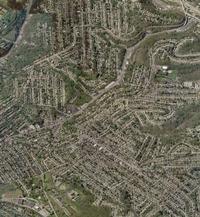Main Street Connectivity: Patterns and Processes Linking Urban Commercial Patches

The researchers examine how main streets connect.
Spatial patterns are inherently complex. To understand the patterns, the processes that cause them are modeled. One process is percolation. Percolation Theory examines the flow of a fluid through a matrix. In this study, the fluid is people and the matrix is the urban environment. Basing their hypothesis on Percolation Theory as it is used in landscape ecology studies of connectivity, the researchers look for the elements critical to forming connectivity in three separate main street locales (as case studies), in order to extract elements common to success or failure to connect.
The goals of this study are:
1. Validate the use of Percolation model as a viable tool for assessment of main street connectivity and assess neighborhood configurations.
2. Identify critical factors that affect main street connectivity so that design intervention can improve connectivity or mitigate impediments to connectivity.
3. Begin to define the relative importance and relationship between those factors, for future input into computer modeling efforts using a Percolation-based model.
The researchers indicate that Percolation Theory and its application to urban conditions has merit. The results to date show promise in assessing both the physical/matrix and the perceptual components that
make up connectivity.


Add comment
Log in to post comments